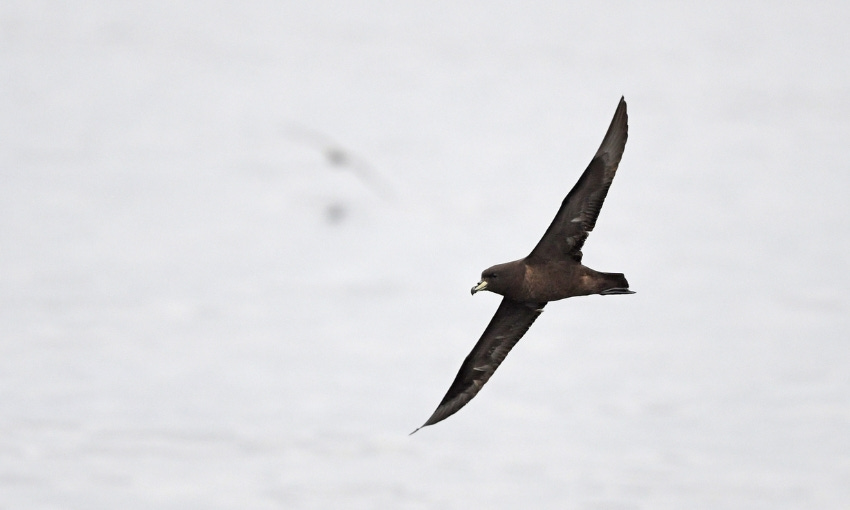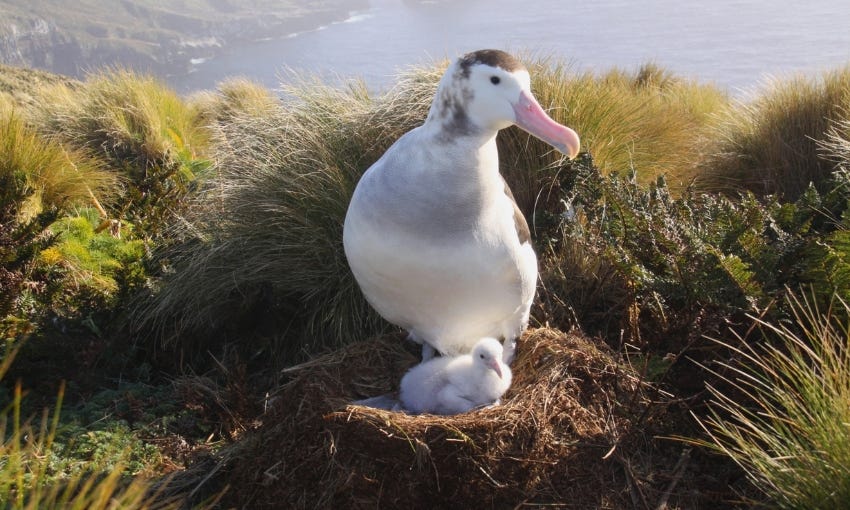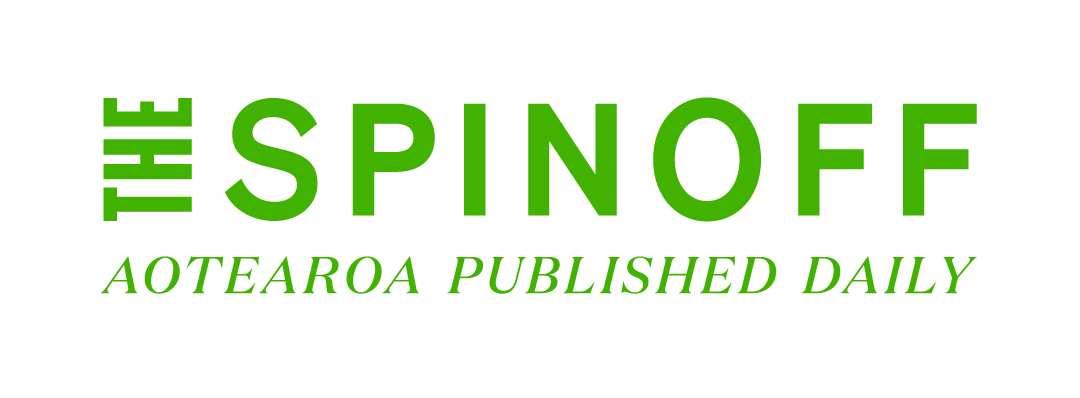‘A generational win’ for seabirds
New rules to protect seabirds from fishing will help Aotearoa’s threatened albatrosses, petrels and shearwaters.
Kia ora, welcome to Future Proof. Thanks for joining me. This week: seal silly season, and what keeping agriculture out of the ETS means for our climate commitments. But first: “a beacon of hope” for seabirds.
Westland petrel. Image credit: Christoph Moning/via iNaturalist (CC BY 4.0).
The 145 seabird species that frequent New Zealand waters will have stronger protection from capture on fishing lines, with new rules announced by the Ministry for Primary Industries (MPI) last week.
The rules for the surface longline fishing industry, which come into effect on 1 October, require fishers to use either a hook-shielding device, or implement three key techniques simultaneously to reduce the risk of accidental capture. Under the previous rules, fishers only had to use two techniques.
“Fishers don't go out to catch seabirds and these measures will help ensure that the surface longline fleet have the best chance of avoiding seabirds that are trying to sneak a feed off their hooks,” says Emma Taylor, director of fisheries management at Fisheries New Zealand.
The strengthened protections come after a review found that, despite voluntary measures, seabird bycatch rates remain consistently high.
For Stephanie Borrelle, seabird scientist at Birdlife International, the decision came as a huge relief. “This is such a beacon of hope for seabirds,” she says. “We’ve fought so hard to get a logical, science-informed decision.”
‘Stronger-than-expected’ protection
Fisheries officials were considering a less stringent approach to regulation, Newsroom’s Marc Daalder reported back in February. The “stronger-than-expected” rules come in the wake of data from onboard cameras, which revealed albatross interactions with fishing vessels were 3.5 times higher than previously reported by fishers. “Insights from the camera programme” informed the rule change, alongside scientific modelling and public feedback, Taylor says.
With both onboard cameras and “three out of three” protection measures, Borrelle predicts a “demonstrable reduction in bycatch” that will “translate to populations in a few years, particularly the shearwaters and petrels.”
No longer an albatross around New Zealand’s neck
Ninety-six seabird species breed in Aotearoa and many more hang out in our ocean territory, making our corner of the South Pacific the seabird capital of the world. But it’s a wildlife treasure trove in trouble: 90% of resident seabirds are at risk or threatened with extinction.
Among them, the “nationally critical” Antipodean and Gibson’s albatrosses have become poster birds for the threat posed by fishing bycatch. They’re particularly prone to getting caught – and dying – in the surface longline fishery.
Antipodean albatross. Image credit: Mark Fraser/via iNaturalist (CC0).
Without intervention, the Antipodean albatross is predicted to enter an “extinction spiral” and disappear by 2050. Now, with the new rules, Borrelle foresees a reduction in albatross captures by the domestic fleet – but also an opportunity to pressure other countries and international fishing organisations to up their game, too.
“Because of satellite tracking, we know they’re going further out into the Tasman and high seas, and they’re overlapping and interacting with foreign-flagged vessels,” Borrelle explains. New Zealand has long been advocating for stronger seabird protections – like the “three out of three” approach – in international fora, she says, “but because we weren’t doing it in our domestic fishery, it’s hard to take us seriously.”
Now, New Zealand will walk the talk, and show what’s possible. “This is a generational win. I’m really proud of New Zealand for doing this.”
Listen to episode 1 of Juggernaut – ‘I Love You, Mr Lange’
Sir Rob Muldoon calls a snap election, sparking a campaign of contrasts. The pretext for the election is the decision by Marilyn Waring to back an anti-nuclear bill and quit the National caucus. Lange, meanwhile, is about to confront a profound crisis, and launch a revolution. Follow now to make sure you get every episode.
Juggernaut was made with the support of NZ On Air.
What you need to know about two recent climate decisions
The decision to leave agriculture out of the Emissions Trading Scheme (ETS) was labelled “an abrogation of New Zealand’s international responsibilities and commitment to reducing emissions,” by one expert last week. Shanti Mathias has compiled a brief guide to what our responsibilities and commitments actually entail – and how we’re tracking.
Meanwhile, Jen Purdie, a climate and energy modeller from the University of Otago, tackles another of the government’s climate decisions: the reversal of the ban on offshore oil and gas exploration. Purdie explains why the decision doesn’t add up, with exploration typically taking decades to shift into production, while demand for oil is expected to peak before the end of this decade.
It’s seal silly season
Keep an eye out for young seals and sea lions in unusual places – from now until September, curious young seals and sea lions often venture inland. "Young seals, still dependent on their mother’s milk, tend to venture further afield during this period. It's common to find them on roads, in backyards, or even on living room sofas," says Jody Weir, DOC marine science advisor. Last year, seals were relocated from a KFC in Papakura and a Bunnings in Whangārei, while Alex Casey canvassed the very best of seal silly season headlines. If you’re lucky enough to spot a silly seal, observe from a safe distance – you only need to call DOC (0800 DOC HOT) if the seal is injured, tangled or loitering in a dangerous spot, like a road.
Join The Spinoff Members
“The Spinoff has given me my faith in good journalism back.” – Anja, Spinoff member since 2020.
If, like Anja, you value our work and want to support us, please consider becoming a member today. Already a member? Ka nui te mihi, your support means the world to us.
More stories
In the 90s, you were lucky to see a pīwakawaka fantail in Wellington. Now, kiwi wander into residents’ backyards. Esme Stark charts how the city went from wild-less to teeming with birds in a single generation.
A good year for New Zealand’s most endangered bird: a tara iti fairy tern hand-rearing programme provides hope.
“Don’t stand for anyone making a mess in your home”: The Hui airs a debate on the Fast-track Approvals Bill.
Ozone-damaging gases in the atmosphere are declining faster than expected.
Some species might have to go extinct because saving them is too expensive, conservation minister says.
“You’d be able to buy a kettle knowing spare parts are available”: How a right to repair bill would work.
The EU has adopted the world’s first nature restoration law, requiring restoration of 20% of land and seas by 2030.
How plastic companies moulded our throwaway culture to boost profits.
Edinburgh becomes the latest city to ban ads for SUVs, aviation and cruise ships, among other fossil-fuelled promotions.
Image credit: Siobhan O’Connor.
To finish this edition, here is a delightfully silly seal from South Georgia Island, as captured by “Inspiring Explorer” Siobhan O’Connor. The image is part of a spectacular photo essay from O’Connor, tracing an expedition to the remote speck of land in the South Atlantic. Bundled up in interminable layers to protect against the polar chill, she considers the elephant seal: “I try to imagine an elephant seal perched at an office job for some reassurance that every species has its limits.”
Seal-ebrating our seabird win,
Ellen
Future Proof is looking for a sponsor!
Connect your brand with an insightful exploration of environmental news, reaching influential readers committed to sustainability and staying informed about the state of our natural world. Contact commercial@thespinoff.co.nz to learn more.
Got some feedback about Future Proof or topics you’d like covered? Get in touch with me at futureproof@thespinoff.co.nz













